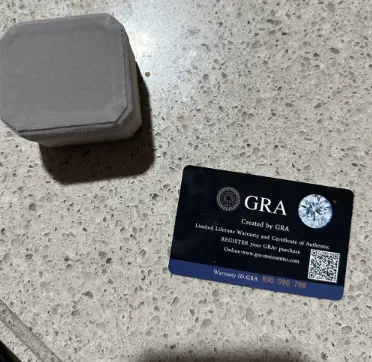Have you received a ring from GRA, a ring that you did not order for? This is the GRA Moissanite Ring Scam and it is a brushing scam! This review would expose all that is needed to know about it!
What The GRA Moissanite Ring Scam Looks Like

The GRA Moissanite Ring Scam is the latest brushing scam. A brushing scam is a type of fraud where sellers send unsolicited packages to individuals to boost their product ratings and sales on e-commerce platforms. What these vendors do is package a fake ring with GRA Certification and send to random people that they have gotten their information online. They send the package then post reviews on a website under your name to get verified positive reviews for bad products.
In the case of the GRA Moissanite Ring they send fake rings under the GRA Certification and then post fake reviews.
How To Does Brushing Scams Like The GRA Moissanite Ring Scam Work?
Here’s how a Brushing Scam like the GRA Moissanite Ring Scamtypically works:
- Fake Orders: Scammers create fake customer accounts or use real customer information to place orders for their own products. They then “purchase” these items using their own money.
- Unsolicited Packages: The products are shipped to random addresses. The recipients, often puzzled, receive items they didn’t order.
- Fake Reviews: The scammers then write positive reviews for their products using the fake customer accounts. These fake reviews can help increase the product’s visibility and sales rankings on e-commerce sites.
How To Avoid Brushing Scams Like The GRA Moissanite Ring Scam
- Be Cautious with Personal Details: Avoid sharing your address and phone number on public forums or with untrustworthy sources.
- Use Strong Passwords: Ensure your online accounts, especially on e-commerce sites, have strong, unique passwords.
- Regularly Check Account Activity: Look for any unauthorized purchases or suspicious activity.
- Review Purchase History: Periodically review your order history on e-commerce platforms to ensure no unexpected orders have been placed.
- Set Up Delivery Alerts: Use delivery notifications from postal services and e-commerce platforms to track all expected packages.
- If you receive a package you didn’t order, contact the seller or the e-commerce platform to report it.
- Report the incident to your local postal service or consumer protection agency.
- Inform your friends and family, this way, they are are aware of brushing scams and know how to avoid them.
By following these steps, you can reduce the risk of becoming a target for brushing scams and protect your personal information from being misused
Tips to Avoid Brushing Scams:
- Avoid sharing your address and phone number on public forums or with untrustworthy sources.
- Do not pay for any unsolicited packages you receive.
- Inform platforms like Amazon, eBay, or others where the scam might be taking place.
- Be skeptical of overly positive reviews with generic language, as they might be fake.
- Check the reputation of the seller before making a purchase by reading reviews and checking for any red flags.
- When entering personal information online, ensure the website is secure. Look for “https://” in the URL and a padlock icon in the browser’s address bar.
- If you suspect your information has been compromised, change your passwords and secure your accounts immediately.
What Do You Do When You Suspect A Brushing Scam Attempt
In this digital age and time, almost everyone has at one time received a phishing text or email and often times they fall victim and get scammed. If you suspect a brushing scam attempt, it’s important to take immediate steps to protect your personal information and report the incident. Here’s what you should do:
- Check Your Order History: Verify that the package you received is not something you or someone in your household ordered.
- Contact the E-commerce Platform: Inform the platform (e.g., Amazon, eBay) about the unsolicited package. They often have processes in place to handle such issues.
- Notify the Seller: If possible, contact the seller to make them aware that you received an item you didn’t order.
- Report to Authorities: Report the incident to the Federal Trade Commission (FTC) or your country’s consumer protection agency. In the U.S., you can file a complaint at FTC Complaint Assistant.
- Refrain from using the item as it could be part of a larger scam.
- If the e-commerce platform or authorities advise you to, dispose of the item appropriately.
- Consider checking your credit report for any signs of identity theft.
By following these steps, you can protect yourself from the potential consequences of a brushing scam and help authorities take action against such fraudulent activities.
Conclusion
This internet age came with so many advantages and also disadvantages. While receiving a free item might seem harmless, brushing scams can lead to broader issues related to privacy and market manipulation. It’s essential to stay vigilant and take precautions too.